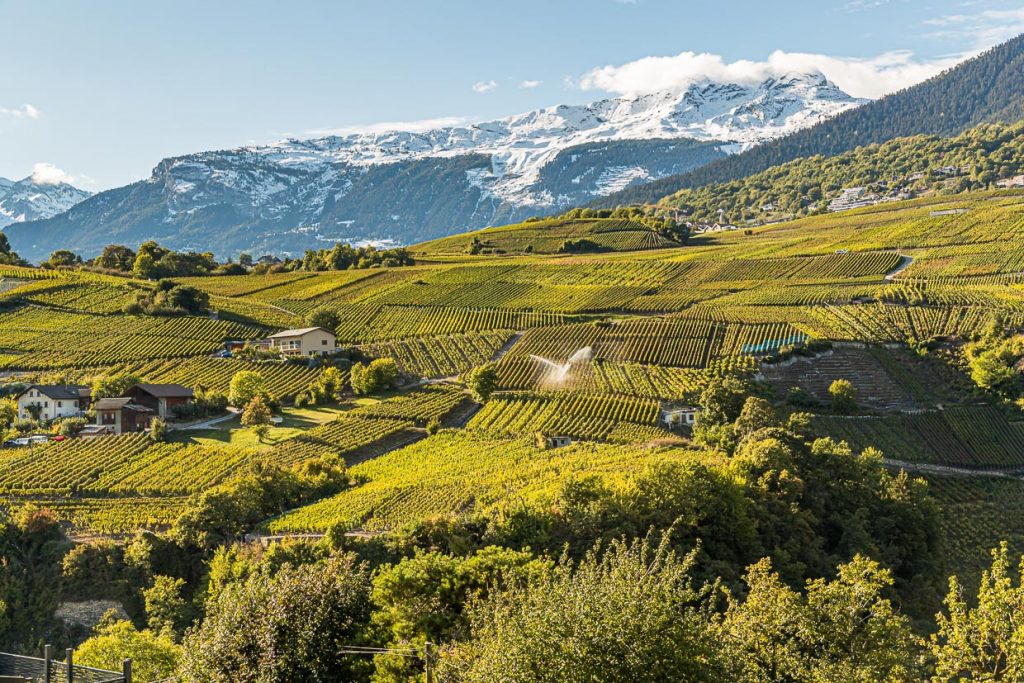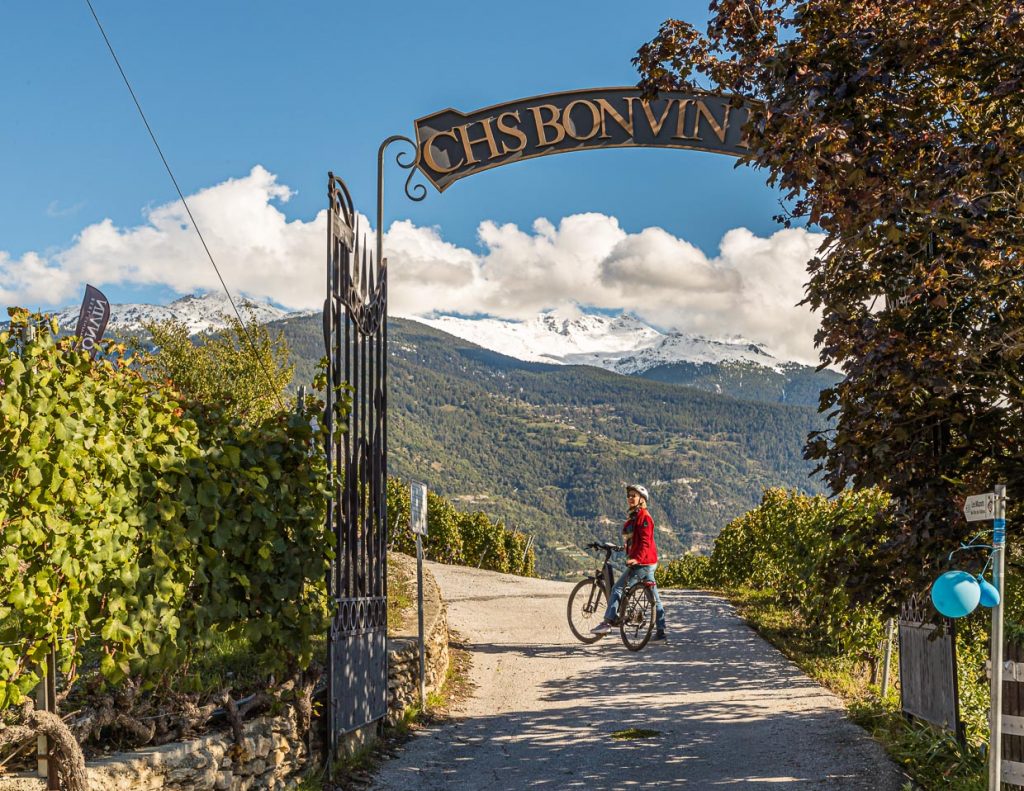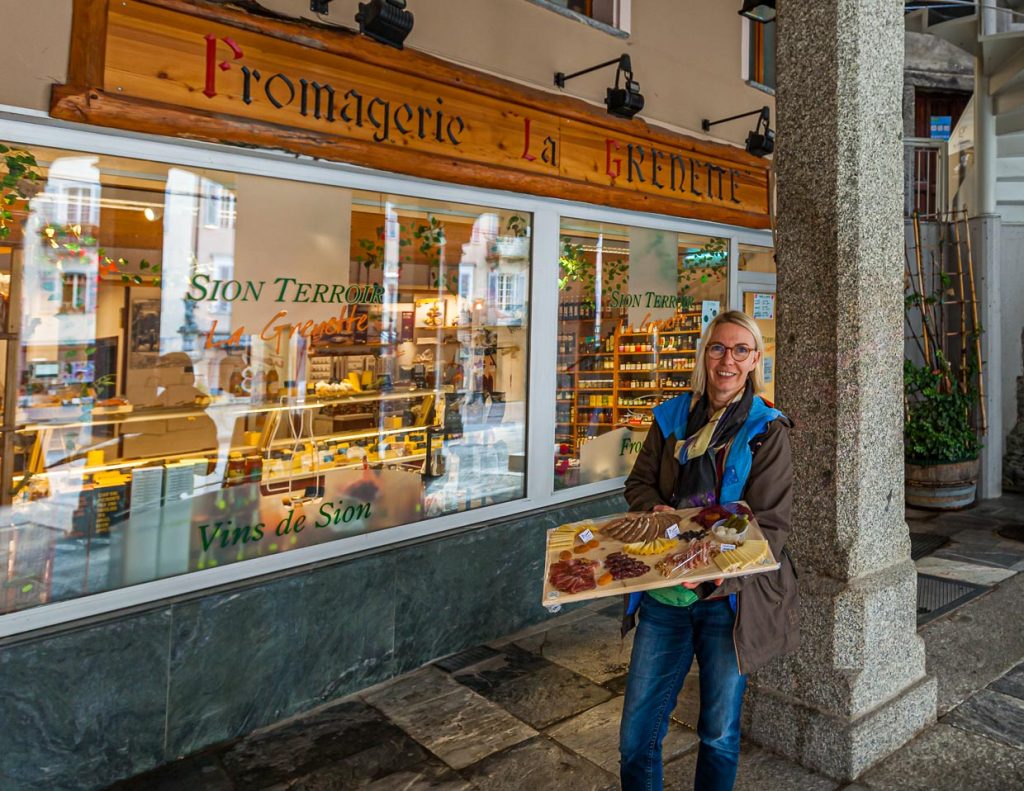In Sion, the capital of the Swiss canton of Valais, local wine can be enjoyed in many ways. Whether on a guided tour of the city, an e-bike tour through steep vineyards, or hiking along the old suonen paths, Valais wine is always a big theme here.

Sion lies pretty much in the middle of the canton. Just before Sion, coming from the direction of Visp, the language border runs between Alemannic and French Switzerland. Thus Sion, the capital of the canton, is also known by its German name Sitten. The castles of Valère and Tourbillon tower above the city. In the old town there are numerous monuments as well as good restaurants and nice stores.

Hikes along old water channels
Vacationers have an enormous choice of trails through the terraced vineyard landscape, which can be explored on foot or by bicycle. In summer, the hiking trails often lead past bubbling mountain streams. In the valley, the Rhone River awaits the waters of the glaciers. The river, which is 800 kilometers long in total, crosses the Valais over a length of 140 kilometers. The Rhône continues to flow through Lake Geneva and across France to the Mediterranean. For more than 700 years, the people of Valais have been diverting the precious glacial water before it reaches the Rhône. There are 1,800 kilometers of suonen throughout the Valais. Some of the old water conduits are spectacularly mounted in the rock face.

The paths along the Suonen are for the most part easily accessible. In the past, villagers had to take care of the maintenance of the suonen in their area. Repairs were often carried out at the risk of life. At that time, the lot decided who had to go out for repairs. There are no less than six of these suonen hiking trails with views of the terraced vineyards around Sion. There are no refreshment facilities along the Suonen. It is therefore advisable to take a picnic with you.

Valais and a climate like the Mediterranean
Here, rays of sunshine meet grapes. The sun shines 300 days a year. In the valley and especially in the villages on the southern slopes, we are always told about the special microclimate in Valais. Most of the time the high mountains keep the rain away. In this way, a wind is created that sweeps away the clouds and ensures beautiful weather. But this also makes Valais the driest canton in Switzerland. The many hours of sunshine, the fertile soil and the ingenious irrigation system of the Suonen create almost Mediterranean conditions. The vineyards cling to the steepest mountain slopes near Sion. The temperature differences between hot days and cool nights enhance the complexity and aroma of the grapes at the end of the ripening cycle.

The connection to the railroad network in 1858 marked the beginning of the wine trade in Sion. Bonvin, the “good wine” was a common family name in the area even before there were vintners in the region. Bonvin is also the name of the oldest wine house in Valais. Representative of the many winegrowers, we visit Les Celiers de Sion. The merger of the Bonvin and Varone houses to form the Celliers de Sion took place in 1992.

Since 2017, the Bonvin and Varone Enological Park has stood at the foot of the Clavau vineyard. The state-of-the-art center is the starting point for a wide variety of culinary excursions into the vineyards and provides multimedia information about the more than 100-year history of the two wineries. In addition to numerous tasting opportunities in the Önopark, many outdoor activities are also offered. There are classic culinary hikes with stops for tasting. If hiking, wine and Valais are not enough for you, you can also take on Escape Games as another task. Luckily, solving six puzzles also gives you three wines to taste.

If the choice of locomotion through the steep vineyards falls on an e-bike, then for the culinary part you can choose between a self-curated picnic or a meal in vineyard cottages. At the end of a tour, a portion of well-prepared wine knowledge is then offered in the Önopark.

City tour with wine glass
On this city tour, a tasting glass in a shoulder bag and a knowledgeable city guide are pleasant companions. The tour of Sion’s old town lasts two hours and includes tastings of three wines from the region and an exciting dose of town history. The 13th-century Witches’ Tower was originally a defensive tower before later being used as a dungeon and courthouse. The Oublier, the place of the forgotten, is particularly gruesome.

After the witch’s tower, we go to the cellar vaults of the church of St. Theodul. Visitors can only get here as part of the guided tour of the city. Over a glass of Petite Arvine, the eventful 1,500-year history is outlined. It was not until 1960 that the Roman thermal baths were discovered beneath the church walls.

The city tour ends for the tasting of glass number four and five in the vinotheque. Rounded off with a platter of Valais specialties from cheeses and hams. The Vinothek carries over 150 wines from Sion and offers purchases at the respective cellar price. The guided tours take place all year round and are a good alternative to buying directly from the winemaker if you are a traveler and want to get an overview but don’t have the time to visit the wineries.

Sion – starting point for many activities
For those who want to concentrate entirely on sports during outdoor activities and prefer to postpone the enjoyment of wine and specialties until the evening, the Valais offers a huge selection of routes. There are also fast-paced mountain bike trails. They wind through mountain flanks and dense forests. They lead through the largest continuous glaciated area in the Alps, the UNESCO World Heritage Swiss Alps Jungfrau-Aletsch. There are well-signposted bike trails from the glacier to Lake Geneva, both on the plain and with challenging climbs up passes and to impressive dams.
The already mentioned almost Mediterranean climate in the Valais allows other specialties to flourish in addition to wine with its fine aromas.
- Rye bread as a baking experience
- Raclette – the original from the Valais
- Culinary rarity – saffron from Switzerland
The research trip was partly supported by Switzerland Tourism

